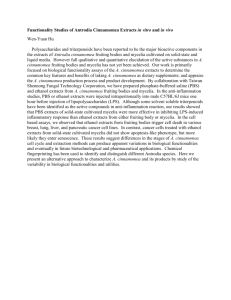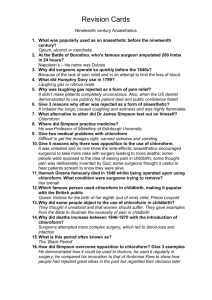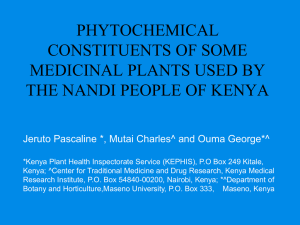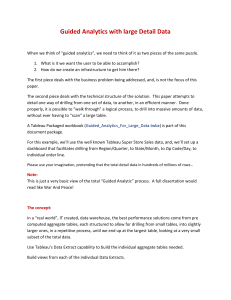COMPARATIVE ANTIMICROBIAL ACTIVITY OF AVACIA NILOTICA
advertisement
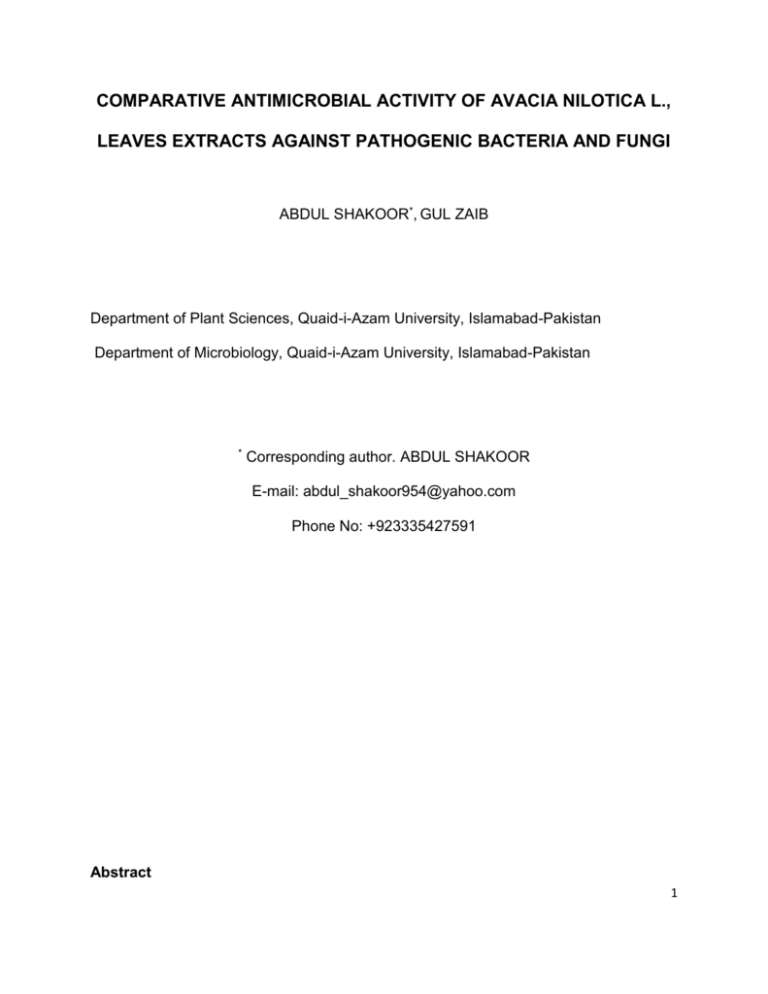
COMPARATIVE ANTIMICROBIAL ACTIVITY OF AVACIA NILOTICA L., LEAVES EXTRACTS AGAINST PATHOGENIC BACTERIA AND FUNGI ABDUL SHAKOOR*, GUL ZAIB Department of Plant Sciences, Quaid-i-Azam University, Islamabad-Pakistan Department of Microbiology, Quaid-i-Azam University, Islamabad-Pakistan * Corresponding author. ABDUL SHAKOOR E-mail: abdul_shakoor954@yahoo.com Phone No: +923335427591 Abstract 1 The comparative in vitro antimicrobial activity of ethanol and chloroform leaves extracts from Acacia nilotica L., was studied. Leaves extracts exhibited considerable bacteriostatic activity against two Gram-positive and three Gram-negative stains. The antimicrobial action was compared with the effect of Doxycycline antibiotic. The maximum zone of inhibition of 29 mm diameter was observed in Escherichia coli with ethanol extract while a minimum 08 mm zone of inhibition was found in Bacillus subtilis. Klebsiella pneumoniae showed marked resistance towards both ethanol and chloroform extracts. Among the fungal strains tested, Aspergillus flavus exhibited maximum sensitivity action of the extracts. This analysis revealed the high antimicrobial activity in the ethanol extract of Acacia nilotica L., than chloroform extract. It is recommended to isolate, identify and integrate the bioactive principle in these pathogens management. Key words: Acacia nilotica L., ethanol, Extract, chloroform,pathogenic, MIC. INTRODUCTION Acacia nilotica L., is the member of the family Mimosaceae and is known as babul in Pakistan. Acacia is multipurpose nitrogen fixing tree legume. It occurs from sea level to over 2000m and withstand at extreme temperature (>50 o C) and air dryness but sensitive to frost when it is young1.Kiran and Bargali, 2009). Phytochemical analysis of the aerial parts of the plant demonstrated the presence of polyphenolic compounds and flavonoids in the flowers. Tannins, volatile oils, glycosides, coumarins, carbohydrates and organic acids are reported in the fruits2. (El Shanawany, 1996 2 Acacia nilotica L., is specifically and other Acacia species are used in local traditional medicine by people as remedy for various disorders like cancers/ tumors (of ear, eye, or testicles) and indurations of liver and spleen, condylomas and excess flesh. It may also be used for colds, congestion, coughs, diarrhea, dysentery, fever, gallbladder, hemorrhage, hemorrhoids, leucorrhea, ophthalmia, sclerosis, smallpox and tuberculosis 3. (Hartwell, 1971). The use of plant extracts and phytochemicals, both with known antimicrobial properties, can be of great significance in therapeutic treatments. In the last few years, a number of studies have been conducted in different countries to prove such efficiency. Many plants have been used because of their antimicrobial traits, which are chiefly due to synthesized during secondary metabolism of the plant4. (Prusti et al., 2008). The aim of the present study was to investigate the antibacterial and antifungal activity of the plant leaves ethanol and chloroform extracts of Acacia nilotica L., against both Gram-positive and Gram-negative bacteria and fungal. The anti-microbial activity of the plant leaves extracts was compared with that of standard antibiotic Dox (Doxycycline). MATERIALS AND METHODS All the experiments were done in three replicates and average values were used. Anti-microial Activity of Acacia nilotica L. All the experimentation was done in aseptic area under laminar air-flow cabinet. 3 Anti-bacterial Activity Antibacterial activity of solvent extracts; ethanol and chloroform were determined by Well-diffusion method. Plant Material and Preparation of Extract Acacia nilotica L. species were collected from Quaid-i-Azam University, Islamabad, Pakistan. A. nilotica was identified and voucher specimens were deposited in the Herbarium, Department of Plant Sciences, Quaid-i-Azam University, Islamabad. Leaves of Acacia nilotica were rinsed with distilled water and kept under shade till drying. Leaves of the plants were weighed. Extraction from dried leaves was carried out by simple maceration process. The leaves were taken and grounded to coarse powder. The powder was suspended in 75% ethanol and 75% chloroform for 3-7 days at 60o C in extraction bottle. After two weeks mixture was filtered twice, using Whatman-41 filter paper. Ethanol and chloroform was then completely evaporated by rotary evaporator to obtain the extract. Extracts were stored at 4o C for screening of anti-bacterial activity. Preparation of samples The extract (15 mg) was dissolved in 1ml of DMSO. This stock solution 15 mg/ml was again diluted, thus 8 concentrations of the extract were prepared i.e. 15 mg/ml, 12.50 mg/ml, 10 mg/ml, 7.5 mg/ml, 5.00 mg/ml, 3.00 mg/ml, 2.00 mg/ml, 1.00 mg/ml. Along with these solutions of Standard antibiotic (2 mg/ml of the DOX) was also prepared. The solutions of the extracts are used for test control. Standard antibiotics and pure DMSO were used for positive and negative control. 4 Bacterial strains used Five strains of bacteria were used in the study which was collected from Department of Microbiology, Faculty of Biological Sciences, Quaid-i-Azam University Islamabad, Pakistan. Two were gram positive, Staphylococcus aureus (ATCC 6538) and Bacillus subtilis (ATCC 6633) and three were gram negative; Escherichia coli (ATCC 25922), Pseudomonas aeruginosa (ATCC 7221) and Klebsiella pneumonia (ATCC 10031). The organisms were maintained on nutrient agar medium at 4°C. Preparation of Inocula Centrifuged pallets of bacteria from 24 hours old culture in nutrient broth (SIGMA) of selected bacterial strains were mixed with physiological normal saline solution until a Mcfarland turbidity standard [106 colony forming unit (CFU) ml-1] was obtained. Then this inoculum was used for seeding the nutrient agar. Preparation of seeded agar plates Nutrient agar medium was prepared by suspending nutrient agar (MERCK) 2.3g in 100ml of distilled water; pH was adjusted at 7.0 and was autoclaved. It was allowed to cool up to 45° C. Then it was seeded with 10 ml of prepared inocula to have 10 6 CFU per ml. Petri plates were prepared by pouring 75ml of seeded nutrient agar and allowed to solidify. Eight wells per plate were made with sterile cork borer (5mm). 5 Pouring of Test Solutions; Incubation and Measurement of Zone of Inhibitions Using micropipette, 100µl of test solutions was poured in respective wells. These plates were incubated at 37°C. After 24 hours of incubation; the diameter of the clear zones of inhibitions were measured by a ruler. Antibacterial activity of 8 dilutions of plant extract was determined against five bacterial strains. Antifungal Assay The agar tube dilution method was used for antifungal assay. Fungal strains used Two fungal strains Aspergillus niger and Aspergillus flavus were used in this study. Each fungal strain was maintained on sabouraud dextrose agar medium at 4° C. Assay Procedure Media for fungus was prepared by dissolving 6.5 gm/100ml in distilled water pH was adjusted at 5.6. Test tubes were marked to 12 cm mark. The sabouraud dextrose agar (MERCK) dispensed as 4ml volume into screw capped tubes or cotton plugged test tubes and were autoclaved at 121°C for 21 minutes. Only single concentration 24mg/ml was made. Tubes were allowed to cool to 50°C and non-solidified SDA was loaded with 100 μl of 24 mg/ml plant extracts were inserted by compound pipette from the stock solution. Tubes were then allowed to solidify in slanting position at room temperature. 6 One slant of the extract sample was prepared for each fungus species. The tubes containing solidified media and test compound were inoculated with 4mm diameter piece of inoculum, taken from a seven days old culture of fungus. Negative control test tubes without extract were also inoculated. The test tubes were incubated at 28°C for 7 days. Cultures were examined twice weekly during the incubation. Reading was taken by measuring the linear length of fungus in slant by measuring growth (mm) and growth inhibition was calculated with reference to negative control. Percentage (%) inhibition of fungal growth for each concentration of compound was determined by the following formula. % inhibition of fungal growth = Linear growth in control - Linear growth in test x 100 Linear growth in control RESULTS AND DISCUSSIONS Antibacterial study of of Acacia nilotica L. Extracts of ethanol and chloroform of Acacia nilotica L., were tested against five strains of bacteria. Two strains were Gram-positive i.e. Staphylococcus aureus and Bacillus subtilis and three were Gram-negative i.e. Escherichia coli, Klebsiella pneumoniae and Pseudomonas aeruginosa. Reading of inhibition zones were taken in millimeter (mm). All dilutions of extracts were made in DMSO (Dimethyl sulfoxide). This solvent has no effect on the growth of bacteria. Eight dilutions of plants extracts sample 7 was made i.e. 15 mg/ml, 12.50 mg/ml,10 mg/ml, 7.5 mg/ml, 5.00 mg/ml, 3.00 mg/ml, 2.00 mg/ml, and 1.00 mg/ml. Only one concentration of 2 mg/ml of Dox (Doxycycline) standard antibiotic was made and 100ul of each plant extracts dilutions were introduced into the wells made by sterile cork.The antibacterial activity of both ethanol and chloroform extracts from Acacia nilotica L., leaves against all test organisms was reduced with decrease of extracts concentrations. Escherichia coli showed the highest inhibition zone (29 mm) with ethanol extract at the concentration of 15 mg/ml While minimum inhibitory concentration (MIC) value was 1.00 mg/ml, MIC indicated 19 mm inhibitory zone. The inhibition zone reduced gradually with reduction of extract concentration to 25 mm at 12.5 mg/ml, 23 mm at 10 mg/ml, 22 mm at 7.5 mg/ml, 21 mm at 5 mg/ml, 20mm at 3 mg/ml, 18 and 16 mm at concentrations of 2 mg/ml and 1 mg/ml, respectively. The chloroform extract showed smaller inhibition zones, 18 mm at concentration 15 mg/ml and 15 mm at 12.5 mg/ml, 11 mm at 10 mg/ml, 08 mm at 7.5 mg/ml, 06 mm at 5 mg/ml, 05 and 04 mm at concentrations 3 and 2 mg/ml, respectively. The organism showed resistance towards chloroform extract at concentration of 1 mg/ml (Table 2). At 2 mg/ml concentration of standard antibiotic DOX (Doxycycline) showed 38 mm inhibition zone. Klebsiella pneumoniae showed marked resistance towards both ethanol and chloroform extracts at concentrations of 3, 2 and 1 mg/ml extracts. It was only affected by 15, 12.5, 10 and 7.5 mg/ml of the Acacia nilotica L., ethanol and chloroform extracts. Where as minimum inhibitory concentration (MIC) value was 1.00 mg/ml. MIC indicated 14 mm inhibition zone. Standard antibiotic DOX (Doxycycline) exhibited 25 mm inhibition zone at the concentration of 2 mg/ml. Only One concentration of antibiotic was 8 made against test bacteria. On the other hand, Staphylococcus aureus had a marked sensitivity towards both ethanol and chloroform extracts except with 2 and 1 mg/ml chloroform extracts. This sensitivity was markedly reduced with decrease in extract concentration. Bacillus subtilis tended to show the smallest inhibition zones at all concentrations of both ethanol and chloroform extracts when compared with other organisms. It also had a marked clear resistance against chloroform extracts at 3, 2 and 1 mg/ml concentrations. Here also minimum inhibitory concentration (MIC) value was 1.00 mg/ml, and MIC exhibited 08 mm zone of inhibition. Standard antibiotic DOX (Doxycycline) showed 47 mm inhibition zone. The antimicrobial activity of ethanol and chloroform extracts from the A. nilotica fruits against Pseudomonas aeruginosa was more effective than Bacillus subtilis. All concentrations of ethanol and chloroform extracts showed inhibition zones except chloroform extract at concentrations of 3, 2 and 1 mg/ml. Where as MIC value was 2.00 mg/ml. MIC (minimum inhibitory concentration) showed 09 mm inhibition zone, where as at 1.00 mg/ml extract did not show any antibacterial activity. Standard antibiotic DOX (Doxycycline) showed 14 mm inhibition zone. The ethanol and chloroform extracts from the Acacia nilotica gave smaller inhibition zones when compared with Dox antibiotic except fewer concentrations. Antifungal study of Acacia nilotica plant This study was done to check antifungal activity of Acacia nilotica L., plant. Only one concentration of plant extracts, were prepared by dissolving 24 mg/ml in solvent 9 DMSO (Dimethylsulfoxide). The fungi used in this study were Aspergillus niger and Aspergillus flavus. After inoculation and incubation of the samples for about one week, antifungal assay gave the following results. Acacia nilotica L. ethanolic extracts showed 4.91 % and 116 mm growth inhibition while 7.0% and 93 mm growth inhibition against Aspergillus niger. Acacia nilotica L. ethanolic extracts showed 4.61 % and 124 mm growth inhibition while 10.9% and 98 mm growth inhibition against Aspergillus flavus. These plant extracts were considered as test and control i.e. with and with out extract growth of fungus on media in the test tubes. The species Aspergillus niger gave 122, 100 mm growth in ethanolic and chloroform extracts and it was considered as control, where as Aspergillus flavus gave 130, 110 mm growth in test tube and it was also taken as control. All antifungal results were compared with control in test growth in control was taken as standard to compare the growth of inhibition in test. Conclusion Results indicate the potential of this plant for further work on isolation and characterization of the active principle responsible for antimicrobial activity and its exploitation as therapeutic agent. All Pakistani medicinally important floras should be tested against all pathogens in order to develop new and cheaper drugs using modern techniques like TLC, HPLC, and spectrophotometery. There is need of phytochemical as well as biological activities of plants in Pakistan. There is need of developing drugs 10 from plants as microorganisms are becoming resistant to antibiotics and creating health problems. Acknowledgement The authors wish to appreciate Faculty of Biological Sciences, Department of Plant Sciences and laboratory of the Department of Microbiology, Quaid-i-Azam University, Islamabad, Pakistan for their valuable assistance during the course of this research work. Table 1: Anti-bacterial activity of ethanol and chloroform extract from Acacia nilotica L., leaves Inhibition zone (mm) Ethanol extract (conc.) extract (conc.) ---------------------------------------------------------------------Bacteria 15 12.5 10 7.5 5 3 2 5 3 2 08 -----------------------------------------1 15 12.5 10 7.5 1 Escherichia 10 Inhibition zone (mm) Chloroform 29 25 06 05 04 23 22 21 20 18 16 18 15 14 10 0® coli Staphylococcus 05 04 0® 24 22 21 19 17 15 12 11 08 06 0® aureus 11 Pseudomonas 04 0 ® 0® 16 14 13 20 19 17 14 13 12 12 11 10 10 0® 0® 0® 09 11 10 08 06 09 05 0® aeruginosa Klebsiella 0® 0® 21 0® 14 16 13 0® Pneumonia Bacillus 0® 0® 15 11 10 09 08 11 10 08 05 04 0® subtilis. ® = Resistant. Table 2: Anti-microbial activity of standard antibiotic DOX (Doxycycline) Bacteria Inhibition zone (mm) Dox (conc.) ------------------------------------------------------2 mg/ml Escherichia coli 38 Staphylococcus aureus 39 Pseudomonas aeruginosa 14 12 Klebsiella Pneumonia 25 Bacillus subtilis 47 Table 3: Anti-fungal activity of ethanol and chloroform extracts from Acacia nilotica L., leaves Linear growth in control (LGC) (mm) Linear growth in test (LGT) (mm) % inhibition ------------------------------------------------------------------------------------------------------Fungi Ethanol Chloroform Ethanol Chloroform Ethanol Chloroform Aspergillus 122 100 116 93 130 110 124 98 4.91% 7.0% niger Aspergillus 4.61% flavus 13 Plate (a): Plate (b): Plate (c): Plate (d): Antibacterial activity of Acacia nilotica L. against(a) Escherichia coli (b), Pseudomonas aeruginosa (c), Klebsiella pneumonia (d) Bacillus subtilis 14 Plate (e): Plate (f): Zones of inhibition (mm) showing Antibacterial activity of Acacia nilotica L., against Escherichia coli, Pseudomonas aeruginosa, Klebsiella pneumoniae and Bacillus subtilis (e) and Antibacterial activity of standard antibiotic DOX (doxycycline) using 2 mg/ml concentration (f). REFERENCES 1. Kiran B, Bargali SS: Acacia nilotica :a multipurpose leguminous plant. Nat and Sci. 2009;7(4):11-19. 2. El-Shanawany MA: Medicinal Plants Used in Saudi Traditional Medicine. King Abdel Aziz City for Science and Technology, Riyadh; 1996:144. 3. Hartwell JL: Plants used against cancer; A survey. Lioydia;1967-1971:30-34. 4. Prusti A, Mishra SR, Sahoo S, Mishra SK 2008: Ethanobotanical leaflets;2008(12): 227-230. 15
